The British Fashion Council (BFC) is making the business case for inclusion.
The organization is out with the inaugural U.K. Fashion DEI Report, which states that only 9 percent of boards and executives in the British industry are held by people of color (POC) and 39 percent by women. Taking a deep look at the diversity landscape domestically and abroad, BFC worked with The Outsiders Perspective, a nonprofit incubation platform for POC, and The (Fashion) Minority Report, a career development resource for underrepresented talent.
“We must recognize that there is a key business opportunity in dismantling barriers, fostering inclusivity and ensuring we are truly listening to and amplifying underrepresented voices,” said Caroline Rush, chief executive of BFC, in a statement.
“The report makes it clear that there are undeniable benefits of having a diverse workforce,” Ms. Rush said. “This is a wake-up call for all of us — we as an industry need to embrace DEI as a lever for advantage.
“It is critical for brands and organisations to align their external messaging and internal practices to authentically and tangibly contribute to DEI goals.”
For the report, BFC and the two collaborating organizations had the support of McKinsey & Company as a “knowledge partner.” Findings are sourced from the U.K. Fashion DEI Census — this public survey was fielded between Aug. 21, 2023, and Sept. 14, 2023, and includes the responses of over 1,500 people in the nation’s apparel industry — 11 interviews with leaders in the field, in-depth investigations into 70 U.K.-based fashion companies and “extensive desk research.”
The state of things
BFC and its partners took over a year to produce the report.
Many findings come from last year’s DEI audit (see story), made available to anyone working in the U.K. fashion industry. Promoted across social media channels and the press, the unpaid survey was anonymous.
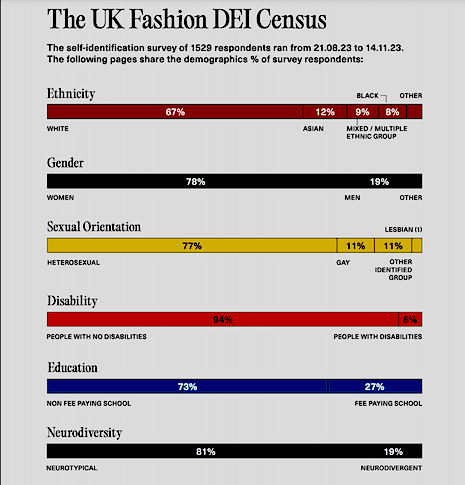 The findings are informed by the DEI census taken last year. Image credit: BFC
The findings are informed by the DEI census taken last year. Image credit: BFC
As for the analysis of the 70 companies, 50 are among the largest in the U.K. based on 2022 revenue. The other 20 are “key smaller players,” like luxury labels that regularly participate in London Fashion Week.
The idea of “outward-looking” diversity is a dominant theme in the research.
Any DEI strides are mainly being made in the customer-facing parts of the business, such as presentations and marketing spots. Internally, even less is being done.
Based on spring/summer, autumn/winter, ready-to-wear and menswear fashion shows held in 2012, 2017 and 2022, diversity is looking up.
At London Fashion Week in 2022, 50 percent of the models were “ethnically diverse.” In 2012 that number was 14 percent.
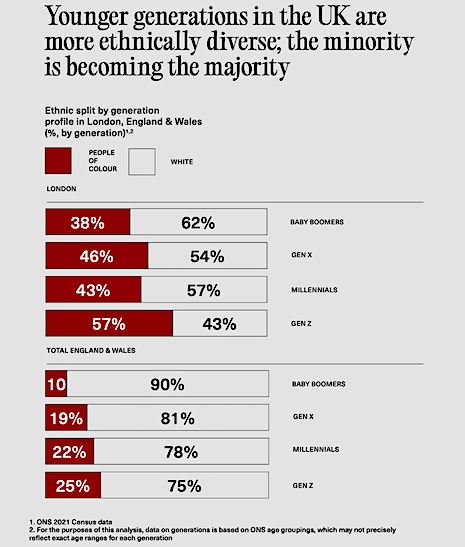 Representation in fashion, even externally, does not reflect customer demographics. Image credit: BFC
Representation in fashion, even externally, does not reflect customer demographics. Image credit: BFC
In advertising campaigns in 2022 for spring/summer or autumn/winter launches, 43 percent of models were POC. A decade before it was 9 percent.
Though this is an improvement, these figures still do not reflect true customer demographics, and particularly those of younger generations. For example, in London and Wales, 57 percent of all Gen Z citizens are POC, per the report.
Internally, the real world’s diversity is reflected even less.
Boardrooms and workplaces are lacking in POC and women. Of those holding “power roles” like CEOs, CFOs, creative directors and chairs, 89 percent are white and 76 percent are men.
Of the top quartile of diverse businesses around the world, 65 percent of those on executive teams and boards are white, and 50 percent are men.
And yet, there is a disconnect between the reality and the perceptions of those in the industry, namely white men, as 86 percent of them believe that the field is diverse.
It is this population that makes up the vast majority of leadership roles and therefore has the power to promote and make the most change. This finding could explain why progress has been so slow, with white men keeping their demographic at the top and thinking that diversity is not a problem.
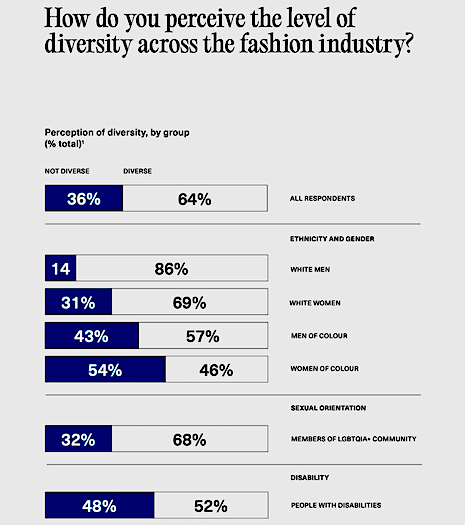 Those at the top do not believe that there is a diversity problem. Image credit: BFC
Those at the top do not believe that there is a diversity problem. Image credit: BFC
Meanwhile, just 46 percent of women of color believe the industry is diverse.
This lack of understanding on the part of white men in the field could be because a mere 17 percent of companies have published qualitative DEI targets, making the data either hard to access or invisible altogether (see story). Only 23 percent of companies employ a DEI leader, making the collection of these metrics difficult to maintain or gather in the first place.
For all of these reasons, it should be unsurprising that half of those surveyed believe that DEI is not a priority to those at the top of their workplace.
“A sense of belonging applies to all our people, but a considered approach is needed for those from underrepresented groups,” said Daniel Peters, founder of the (Fashion) Minority Report, in a statement.
“Business can then benefit from their perspective and thrive.”
DEI driving profits
BFC intends to track and communicate the progress of these issues in two years, continuing its efforts to showcase the financial benefits of upping DEI.
According to the numbers, diversity can unlock a business’s success, with those that place POC and women at the top outperforming peers. The report finds that an inclusive workforce improves decision-making up to 87 percent of the time thanks to more perspectives being involved.
DEI has only become a bigger profit driver throughout the years.
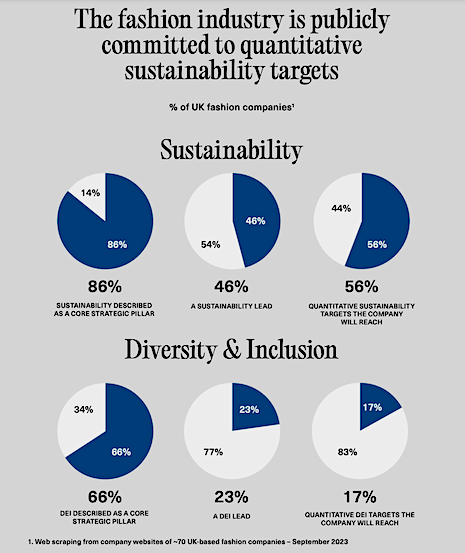 Companies that show that they prioritize DEI will secure a stronger workforce. Image credit: BFC
Companies that show that they prioritize DEI will secure a stronger workforce. Image credit: BFC
In 2015, top-quartile companies with women on the executive team were 15 percent more likely to outperform than bottom-quartile companies. In 2023, these businesses with more female representation are 39 percent more likely to succeed in this way — the same figure goes for those with an ethnically diverse group of leaders.
Additionally, the research reveals that 39 percent of global job seekers have turned down or not pursued opportunities when they perceive a lack of inclusion. Employees are also seven times more likely to advocate for their workplace’s performance if they see it as DEI-friendly, and are half as likely to quit.
Externally, customers are more engaged with businesses that reflect their values, with 50 percent of millennial respondents specifically saying that it is important to pick brands that have a stance on gender equity.
With increased legislation slated to force many companies’ hands, those that are proactive are expected to be well-positioned for the fashion world ahead (see story).
The inaugural report lays out three levers that can guide businesses through this process. Leading from the top, getting data, and creating systems and pathways that can holistically increase representation are recommended.
“Our catwalks are diverse, our campaigns are diverse, our consumers are diverse, but our workforce and our decision-makers are not,” said Jamie Gill, founder of The Outsiders Perspective, and non-executive director at BFC, in a statement.
“There is a solid business case for a diverse team, which is arguably most relevant for fashion,” Ms. Gill said. “We, as an industry, should be leading the charge — because we have the most to gain.”
{"ct":"MQPt\/jcrSFX1JCaN83SzucuHIBekgIpPLQ\/wgsoQwCbxGx5OlHAUYq4YcoygqbMQHQBGOiszjSEi+Uc0AqHnxgRUrGIpWX9feEAlkC4B8LS0E\/Xy2JW30kwh5KE7V90QudkLYFL4eM6fEStflDBvv+e0DcLLEBFvZgKwbHshsmFNOj6KS5W0F9IbmIfFv4DcSn9629FL7hMR1ceULPFqrG5tJQJ7xeJ6VurJ0L8tKTt3IvBxrT\/v2TN3yYFtYWwK+8eG5lC0VOLKv1SUvhLMV7SQWWY1ondiCNOQ\/O8g49lqSYAwYAksL6FWwlIP5gG0OYLTOGxBfrQ5tQJdAR9KWUKRWQojNLw9ja2eTez2Ez2x+wA1TY+qKlPMQbtJyMNRe8bnuDh9RNzy9fXpeC0zA6UgMOsrxMt4fMbkTEt6ZvfsNE6d7XawcqByvkPQHlnFn4nqgtApeM+5Drge75cuWeRoU96zchHq0gZxzO51uo1UV6SY7kj65IGqqhjASxXN2cc95JyaByKyzZGJiznjpkyIXf6eqF\/Cmmer1XvIGON5qSUGJ4akzJNF6heYe8HoVgLt7zO6aX5sYdDlWuO9v9m\/VLhUQ1h1D6KoGqwdrT1VxighrLK4FDtM++lNJ+4dXEYqPp3wU8AL5GaRUFoqZ669HqP46UtKGbvfHNYcAqmaOYyJbCzcLmX5OkTZeqdTzUjiO6+1Owk8YDk+qqNRd6a6t+oujcT2Bb7oZI0S3iAtoVHqRrCypG6pM6ECe6iVQbbPDNQwxqbeIZiAKC9uiGQVyhmVJkjJAH86SSYWoE\/ef0MmPm8FFdf3gx6YsYc2iFF2F3bnY4vC3G3QQH+TpCX9PXjUhnFhKyfOLk3tprwbCWmgJnbvwAZvULOR\/MHZmRyJmZQR89hD48hup5ZNCqZ3m46fEhx4axSpqPvSX2qMBkx824vfXF4zfrqpnYRumdUz2oudmciEQDBh1e2MirwCBxBMJ+3uW8byyx5\/BmIFnQzAvJv\/xNBEBM246YR6\/BfiV8hmHyAdM80BUgKW2YHcFJWdDHFZfralZ2roSHlfGCS1Z6s8c7aUlk+ZnH7VaZ0j8ztF8cvjU1DeY5p6THdW4FT60\/NkNRKhSy9W6Cc9t\/0XKc4vUasGhXfebQlw7eGvPFVMeitai6BZ69bsBRFLgAPvtxSQj7rI2oj+ACZgaQ2WNGHKL0cvplUH\/8\/F2UwA2cZTpX8OL8MbVFgCpW+YIuIiRY301JFvYJSPCS+kIEgZkn5jIjaWNqDAE\/sYsocjg754WlahuaouI\/gYvYpB+3nBLRy42TwfeAth5V3yY1FEUf3IDU5dQn63xHmkKjIc7RlN4PWaw8FonAjrRYR+2E2N84BlxrHC9fd0onRmlmsqDJ5XVG0FHZ82KOsAKZoxolW0gR7u9xyWM9zIf0fkDvTyljcCUf4ihY+HrkU1nemmBo8dvTxHN53tVGAcqpFzt6DpZ1Osvv9g+7qROg4irfi8xHHWt5Rjugm1b2z+HzFzuhiaVgcFfony7M7yyFkjnaQ\/kpXp1qScqKMIO\/HRSzWr+Rumh9rJkMSn3oq2LE1DL4tUmQFFFNxtbeq16ZLkIFGs6G9oEWxhalAEaTtzOYmbHH3M8R\/khWk07M+\/NyvJCT2w\/8zFnxRsmlpJxpou9HfDHxtBwDPJU7046Hq57ZALcYByCxE0wMHWGL7t53JJgrNRY++zM+W5S2KA4rIIGPaOdP9GVSDrSVbNblkQwTXfmpRi9gmGQZQ+DU4+vJBFoH5ggQm5RCe4TQAwTsGsAXt+093Z2MXRSfCuScdmnNczBxTONOuaN+eoHjVhZiAki7IpBIv9PCizx+tcuY1z+RlXunxSehR1pVr+oiXd\/KQbUUwwg+a094\/YKgJ6dCaIOLOiPVhrYOZvvh7ZzIJWUNj8lbOOdxx+OOgOKVHUSt2YzOiSxCWbkegSfhyEIUPm0FiBA97StKO5VagjNDOXDQr+QBM0p34zf+dmCLnmwd8EiG6JaqXymY03LMKldzl+7YWYCu+J07\/WC1cEvwQz0dLuYl+Lb\/0hLvp8uMeuyM9cv6NixeVnhL8Eqw\/NeE44E60d1CfHcVgDOHMIJF4PAq3v25bnZPQCzj\/DVeVQAxlzoHbFyKkZ6ZPos1nMGgBXOqkqkegwQOs+dyW04g\/dW5Fw64mlLNDkWMcx4TeREsx2UBdTinYL68V0sI+oBQtuHfOfCfRC6ljac9YGdlrrfCsw1mNdTcfROE6xTYcM2pH8i7lF3JLxXWay2oJ\/QcIlOLCehxj3t\/B1Jn\/74t0KX5+NYUBI1wlSDrQQvEecp+XCPvtj2A7KGRgZ+4aJnjp4\/fm1h8sWlnHNHVwWp\/eYWXlCiY4oM1t3FfVXV5NS9I1+cT7zfrK6Ir1dbz\/qbc5rlqnBPJk06a9vFixlPvXSKuX6jYK9qnMqG9UOKrooeUY+nDejnONj9ikpsuqjs+jOY7oLKUux8NdGivojOs\/+Bt7xmlxEAWEdM1hB9ut6FP30pyuwo+2ScGAIsBjuWynDAc3VjZ5fjnpCZQrJL9tiu4D0G17j0xpzmPxElMpwxXoukdLkLSW9bQ+D2IYo\/4tlwBIIZf9+U6hX2dLiPK6XM0xgK8LDs\/TlaSxdBAYAf9D5\/Rx84ipE8J8ZDk5JT19kw4PAp4j6Zjn2\/OBTtRhzGEtAe3B2EZ00MK8SB9d3rpIl0Gr72Mc2JY31IMaNDmaeruaHzYOQO0tuIusDbbsZLVx0zkEZ9WnfFtbdp2Koq1FUyBRfA7GeT11InKkysdLLBGSZd5fsdHQTnJbKcKz78epeTSGp5KF7WhjZnxttn21oziA0ZxChmNQpvIGWQzCKkD4LR0PWt7\/G6x4VtX0Wy53aP34gQ4Qwb2pNkzyaQhV2DLseXhO1v7xfuECXJDW7I4gwHv6GkolbUCtI179GfyhPoLp1Iq8FSqwZa8LdrSq0ZY6a6W+dkiR7n+lxeLHxxF8viPxkE0pzJgmQW3JPZag9jltj8Z4PNFscX4s1RWmU1ZqBet916ULsdyQZVfMjw5iwe+CBjA7WeQfR2k9ycZf3aRNcnHc8cJIGaY9qETfX1UMpFJQoHrd1qw3W1Qu0Y1+iZSMkT3NqJeQbOxonIrCfEg6K\/vy1pT2HjpJ\/MZJjOP53pyXBu4Jrn0ebcw+SY9dYW0t2BOJJ6ZMIw7JNmEe4YiPZxPzh9t7tpw5tPXhALJIFCve83pkIGGpwIfMs7G1EjSMlGBGS4rShjoyzml+sUI4yNaKTAks5NQn8SkuspFh9+o2GLMKFG0suuhfS1hb8omWPC7dxP89ye6QwELOzny4Nhe07SK7NP6oS+mjbMBsM2rLfomJJWE64GrU5QrJH4ltoHllPC7Y7DCYbi2WH4ZJn+9NQp66Y4sbfImDWFhUwolSno7dd59vHz7RkpRK\/5RRkQoo8Pst0k5cv6NPR+kaNmj6hccElKlVjriMxVrRC2Fu8UJ1gLifDhvyI\/IA32SNsTcKwy1XKFCfy9goDlPFDW73NJFTEPIq0+7g1SrMYqi2CqZ7h4ju5G6eaK95fiLwEzRge7wEL\/3zqDZ1th788lTNulhg+HSKpwBKG+WsQC\/nDzQimTTUFCq+mHvysPY8arsrD4Ea3G6SY4WBtWwDGLMdAuzW4CEVc94qt76mG6quaiEGSgn2cn8GDw2VQleEnrCbyIl6kGb80BiBMGrwV5LTfz6SWujORIQjYlhM\/jbB2GQbwXHLIenGVpkR7Ej8PrtN1N+FLxS7XvgEZOSAS4L99gmdZTH5rfOhM3gCDlz+5+RSKjHX7T8ocUyBk94xegQEyrQoCbxqqUdtV7ZcTMKtY5R\/q\/1uPX\/muEUQvnKyJL7PjmWTubdFqG7SzX\/Q+4Bzkb3U9RgXeEtLuN3KGNC5czoklS98kmSLzOYWTelvTN6FF2cFw0v3LWDDwSXR44WBcA3NT0yVtfzhs+w3LRqMS\/0YNtRhjnuAdm5RwiOS4HQnKiCF7pCwVUzD5Q\/MNzl29KoK6Hw85Bj3hiia1ocf5CB0LfM0TJ8gsjd+LoYCWithTgPy8A2gX1LZyh+VS2KAgdqXGFrpQc3RHipK1gW5\/69NraERoPkjlMqDFhGW3kAnrMHHYCb3DZT7ginmziWdxMpU6sNVY8II6TVDAhgqhcKUudeZcjHF50FCrzcBL4oAd8wWVIRu1HTaS8ds\/NjzRHnTqoUI0Inwsi3YGM0k7n2LWqkUi35CvMC2AT8M9LpMthVqpdzRYk8HK45NK2znU08JQLSxElymadzB4vr+dHcUY24XmOHSx03MsOy3LOINv0VPCEV5jcecJLVryJP3p896JqKqdFtkTA+MkBWk6LSIpclBW3tczNWYJgwGZapmRchBrn6kdomcRtL9eE9+Y8bs+kg0zCp2u8vk9JjFpRITAaAvarTtDKqd2wGSlkx5xf1plLHveKVkXWXiIray5m77xB8WM\/2BoSzV2mon0aZFSzajK5loh12i+btzQgnBBtl5ulpTXyGTVAx2iu77\/VDoxFPbui0TIi7SwKq6NCp7Iur0kWy3F1Ra7\/OyfbEL7jD96GUwfSckoYcKrkWBREuYdThK4wfuCidObLuiXliB1VUiQ80WqwcQNITx8LjM8H6P8q5UYM2t+XUecKy0+PvRqpzY7V0lDKFPuPx8sXKlKq\/GoDGM40mSY2Ber9aZG7y693KuUFblyH7YUV8hsGcyHz3LmFgIR3HXMNnr\/cp6V0Xsc6LQY5vmc68IM6VX7Qn7tSshIbALvQiGgcsOOkNYsjLQfVcMHY1jW+oNqneTAl1EcgS+t2en3ap6fqaxlb7IpJU64381rwTyTzZ1sNy9UJX7Qg9fMoJp2ldyFnw0lM\/6BCtmMDTiLNqts6hSg97dzc3g1CHRNuytdUQzXiLlsuCwbb+jUQuF\/BvZIfZe346da5u0kk0mNvabCcMKGYXiMMhC\/MySNDLFbA8SIEPAmDq+PQqwMXKM+JX90X5anW2SMy\/OfXBz7KaUoQBJ2f1A2+djaQ4Q+hYL05eVLNEwuYKDCTyXSvVyyVVkzuBms3tHBiOtABZF5fd5hHeSmFNCgccljPmVSibIWnbO3ZxHBX9nlvAYJGMw8hqOyvOoQOYHBGgNN2c504V1\/T+ipac0tvBC7Yl\/CHsnmB97VR1bkInRr0wuyKyMH+ExYeFM65k5YUI41YfDa8SKxgmkE6xEZokA2I86YbmHgxuV1UtOUtJOTFySEsYn3f0ShkIkUPICrag0nu9eErBuqEg9\/R7GYMqXTDKdp6ldK9sKxek0Meip0AuVIlLMXC\/c4x8CV58J97pTM5p1SB7\/ifK+LqKtzmMaKU\/nexrsERljfnXYAcraXW3H73XhRPMNtQgDa5EiUuaye14qjQGv+SvlHV+SVhR5ldwgGg78G0zgx+qK6sqx84h3wv\/9FDdiNqCsZ9QHjw52QQdoEreL8wE5ZPCS3zdTzou3ix2SeipRU0IS8onZpQEs0p5hA4\/a05DcLUyvnd+VtXqwYJRyJQFfryEyANHy3YMQDcQi+oNC76u0bS87uq+JJxVGheyP24T1Nt0f5XRyuGbMtXz0diuyJSzZdAyt83vM5JNbchpO7vzJVecJLoT3s3AvZjdgS7pD1B9QwVhf1WzbNL81MKjqEp3EgZ2qBDuB1BYhstARevicZrpyBZcrIgnjdU29LZbzWs7hDuCYxy6AtDogrdTz39Hr14e\/G0Scucf8CWKMAI4yZkkdZ1Sp9CGm3Mhi6unN6j9stGQnUuEaT69G7NBJpDrVDlIXoa70ebmJSqIk3kER89YVu1RKZe5j4TizWwA\/N\/gdmV6ljKzv+Gayq0RrDdm2zDJxtqILnUzj2E6LCVIw8Itgqfi0AzKWU08+IRhY9g1a1hxn9i82+OZTQefD4t63Q7icUg91GRHVXsUNi0mg8W5kwzNzDbfzOIWjFZwFbfeLWwnBM0287o4hwsnV0C\/pigYN18TpRKTDqyfTNSKZSRoV\/AH8c\/cTSb3T9BBTKqhEfUlMyd\/dnIIZP3x0JKKDBz0WbDnMlnCfgb1CKA8ODzWm3B4RnRvREoQh7KJiFvPr2VfCdmyL9nPhLKj+K3asd4d1icMxOAgcTB5RgSAEQzYUxTiyW\/5CVIiZycQTEiAyLnhYYeyuOJLuh4Mpfjhb1SDEGNh4XDxAzfTJ\/oUkpLqE+s1A+cGkxWIIPIBi1zXNoAACRENTpTcVoi6mlCt1y4jcsPsRFU7NngU7olyNctgUSb1zI14dt64rS1AZeotyz5xlD9\/2Mm8zoam7zAp4Mw0cX87nd3X11Eo8+HJNudbtJzWY7Qq\/7EpBUGzHWEQC0Sa\/WBVGYTY5sqWzpVevFLv6iM1eWp8edJHoA5qrxl+KRHyQPUDnK6WEwxq2ookPSadHEA8\/L4bZi2eXSJ9lZ1YQvpV2S6wsnpsJsvZXTKKNpdcPm2LRwBmN6lAVm9JXzBMcHCh2rCETWYJyJ9xpS1WxHISAd5N32Um2BpD2MfvNLcnHvvo0AUBPsVsGjJj2gv\/1Qzmu2huD5XAxgbdyGByxzLj5KiJX0gHq2MVUlozA8e6lxhU69x95jj\/PPzpiEuIKiLqB+FCX3+Edh4ynhuMyjRDYTygSnQj6NBofHFVVKx\/qdHhh6uAoBvT\/m\/IyEyXRBqoFZ0kmygenQhKYP462qN8FNHwKZws4aT21eGfhwNi85w\/g5N4WSTo4sk3UnzkZXxmSn0pWu9l8tCIMaX5H7iQz41ViCmQV66T6MUfknflMhHswtIAssl+q0r7N0TyQ5vac5w\/32pENU7OZVLwZ5GLDU2PU9KtION0qQYqqk1IwKOPxYIdfq3YeUb6aj\/rzE86hCA7tM6vR0R3qpEEwaxHGKW+rN+WMaTACrvOSZ5kdS\/QK9O54g2RyKz4VB5QmNwXKHXpY7gVxr+86279Z15hABYBPaeecQMjYbma7j\/ic14Ksdc+Sa12EUKU\/RfT+2WgDAy5fzMFm\/YNu3f88q6wmTavdgtU8NA9QLij6lCpq\/bcmuCM\/240tmzcMU8b6glEtunriYptCJc3zoHNNzcncbs4banTQLrYQ4AEuUcFl\/4vMmwrnxjTH6sQ0tU4Mw7AW0mJYUeuWIbM0UTf\/7kNlEQ9wLh3wyLZHhq\/jlrHhDpWglgFntK21ZkTEeFnWKCvflXimKOWdRhjIwqYZoWcaujoK9GFT54wBUsCreS69YzZRqVpe\/x0sv7NG6Jr83XcI7n3RlWxCUSVGmd9rX72IeeGzfzeeI65xhRQUgQhOIj1F\/bIYrMIvnA7UiGTTttLdR4PpQXC1uJVSttNqLDCZn\/BwRjtJzRwsihafSJrgH58lRjhvHN2q1cUFhnig+1sH7v1GT1pXaRl90+n+7DnySq5xIBish8pBbByyFNbGl46vEVSmD2dUf7QBg22pfB8M72ct2PqxVVVi1\/4\/8xTAwPTOX0Po2hrB+oNqUeCXwp6hthFqyvFw3y8tiE6lV4wxKXLyf\/mpHNyiyfFNBA9DzNobI957kSn+KmrtWEwZ6HtWsJgb3dTag2lH3BuMTBD6vgcwkm0D8Qxzt28tXEQIU9z4yzUHNp\/zqW54H9xwrDMRcNH6ZW\/okjAdh\/edys50uVdueJCCsZXYFNneaBGpfCAyqDDNwvwX44UdlROw01uND3r6mqqcjR7gnWnDvoes5UKVyo7S1xKcVoPiTe4FZ47S7Z5O+5oFnFNSVFC+Y6mFjEd+kNA5Gn1vdup5adAKA0rplVx0NZv9yh4+RxFCxdABO7QeElAZtSmPO\/87zTT8xlOGX1hcYFkSxjCd7Gv1xHd9sZuXQJL4DrCC3Rc2t4vM9TpuBnYma1YcE2i0LcJnYYy\/7f9ypIYHgBMoaJnpsKf2dldvP+ITF1cV2fpFYJ0iUyEMIxpJuhe28KATSMSHAKzKNFwc5qu5mCQ5ujudTDz1y8sm7ouNWu5uiNo2oPk7ISzjHaNwjD17cLTE6K\/XhNVIxNbFlxpzNhax8YMiMwNcHEI4uFAT2a0rNSlM2ceCqBW5Nqj9QglM1o5DwU4Y8XHsNpGtBIYeZICKisN\/LMBonXD8YwOrY6HHGyydJk8kitCcNuF2o6KufgSmDZSZhmW\/Kl6NWumvVP1i\/2TG99ceRlugsYGcTmV9+hKbk3+5\/y+m2OWHsHv3XgYv4Trqug5gq9zN17OggSVJwDHF3N1S75PkeDEDqMuBiNKomm+dm5r0hs98jiRJ\/KVN91iGb3goLB2LXvevh1bLHNtd7BoazshA9JpJya3k3W3OlOzmX0DnyXCTiQeHoO0jaeZCup6kiaT1yi3l6JDKa0JglD5FvUENZ5XCrMRY2E2rRCZGrOHsX20mv0\/AslPE7FODpJAdRr5cMgAlCrWj+dv9\/NYzIctabrN9wH1luPuwtVmIMmsHqoTT3q\/84817a7iNqQt2EYpDnC8Z1lQatGF63OoZvSy77Kv96AYwn9\/lr2gnI\/pZWFqXexvWPIYQlCRkqW6LhqXtl4gaQ6C8inJLTRVPBlJfuzeSk7J3Ppr4I5\/Ye7IZZzOQuCmLPmeHEyORtZBDmITOfo8t5eV6p9rtYlfQdumsHUYZ1NJ+4PLwKSGSroU\/7isOnikqUWp0b90bbTOLytKmxCfiEY0pXS4jD85+\/5imr03738V4YXBURYZ1ng6LpdbGK+1Bwg+mPkZho7f2T2KfDOkhGy\/tcPC+1nF4\/3HTaKJchhC5Q6TCY+CB6iBxTCUKQ7PBw898T38YIhJ75WeXjkdxg99p7S9JRNIm9WOtv5CBQfdulqoZ9dwxVtmyOlDqvuRhdOVaEi1FK9R1nJ+uM99w27ExwiT2wh2zGciAFIFInFL9f\/nGZ2KOyMQBasPOfXqCba9CBIJ4AtQn4JdGdZ0PLiC8CdFfXjFa6S0KBmZTAK5IbCoRzfpbvhHv05czyK8uJoXwWLA8N8WnyXjktJMrCijssjv2xtSkS8EsehFmi4CEdiGEvHHjGi3h8vw63gkjJI+PgHTq+tKhV2HR3LrzgCljj9FFESu4pNFdrLJc2dWQhojtCmIqBKaNRC8UPEeEZ9bAQ0T7SsfAZWxSYCD\/ITBinz5AXFF0u4+p+kIuGJcLe5wPTuXBKHutjsAVDPeCYY5uVrqVlKi\/Dd8v9zml4ho3t2w3k6U+WFUhv+H3kHwywSC1Oqwu5zw\/Z6DlVJcsgUVcdmRonnBeeHVp099Jh3Z2pfnhLBUr76jDKeEsnTGpfHg0A1Fbfyh3\/GQ\/wkjFNnQJ14Fq6znBgYVPqYSwxkaGgNbiMYuZIOO1a2CWM4PmI6Kq+5GjhuWay6Ll9georSL7CwuzRuRNm8FCJKCmpnbrlpRyG8erx1E3UPLJT8hPjnkN\/bLhd9qhbwcjCEmN09zQ3GZLQ7BSCPzSvQu8w2vj\/xdVLF43xplWTSBZ52eDtgsJSP0cr9ZRlSbDYcm5lP7OQPbNHD0sr9nvi3ky\/lHAhGw8YDKAWb3tC5z0ajgcN4KTVbsknp4L6GmzkHbU5hgWNcem3WUlqKSVgSUl0NTLHnz3J4n\/tlGBYzDDM5sZbuZOkhDukiTuDJUy8n9RhkK9Zx5yy950uDfBoqHZuWfHYFpNMKPYQJLfZcaxtuMRsyCfjoU6FxMOw3mXPu7IPLefl+30hlcsQ95jDW3V5tk7QSLkegx10Zd7tSexInOGb1h96RMJ5n26aJXkTGhZw4HE4cp88DRJcBu6d4kXezMwvwU78f\/bvyWfg23Pia47Ol5Uya7\/aJ+5YeUn1oAHXJZnazgiz8sTgwjgWt0V0ZGD0jPJCM8IYPqxfr6GtYaUcbx3Ymuw8GU0znOpQGNk9ILwFDrJJQ5paUSJd6tFuVzmGlSfDBtkJCbabCy6kwXZEIfdxLuimFVe+aJuTF7HskxiuEaRIL1hfgFsr5BOL9\/DMGoU+hsl2GvuNCOwSUqlBq9h4FEXSQwcG3146UNI4PKgVb\/dNXET8P6j2mlaqazQewhQKw0Bk6TDFkYsvjPKYwTLEdahAogtb\/ktjdaJVm5epNID7LP9OG12JQSOoz5Zne5MLb4e9eFFOgJlAFwaJlf11IM0Dc7ZhTksVnf\/T6gQchr5mILjh1Yc+v8E6UEjP93nga4X7HJF3zmZDLbSXhiyYyPzCqOcjuV5IfNCGJHiYY3Uo9jx8IDxk9Exv4cPxkS4ggYhe2HBGY5OnmoHAmBP9nAUApr\/ELNzsegEOx2SlAvzuH8Ctu1syYWXRl3twnZOOlRM4ksD1bFAYJxWe1FLXTaCa0mONRKKioy8OsEkybJuxGkQ2C3QrqQ80xly50XrLKRU8lOY3nsw2pPtrxOcZ9lvj+99manSncbylCCcyv10DTQnEjdt72vER6osHo9lh7ondHLd8XLEVT\/qFLhPrHSU+YHZ2\/\/GXDQnDAfhbbvu4Uie6vllTQ6hapBrQ4vE1rv4O\/wxsm0y1e6H2T1B9zXr1b1UfZ1rnJzPnlhrcUOCYrseCDZuHqSbk7aKQR6M4q4sNZEzllvxbt+XSOasvFCJzgo4utvfOZvjf\/p2KqPITH4TYmktjHn2QXrURFNFdPJZkfELheAC6I7x6ZJkVn07Ows4yhXQYSDz0ZA0NuT4cBfak5NUGLH1JnE+1ikyRPkwBBxuy6x49\/cTqhMdo7dL+mS5KSkOAeSUOL3SehjhbHipY6e89Pfj4zessGN8WIZego8aBksa5ie6VsarR86t1bb+mgNU+1SmpLdkbeYv0NEmI3kXffEJg5hjsCtGIywSGnUBQWkwTItwwvwhLEc\/tIDzp8NHkox83oEDOPDBhbt9XsMAw3l7R16+beM69mBdsIh96OEdRxw83nWpNSwgya0eLj2mVXwclVuqTaqXQDsYteXQTn\/M0DTYS4Kj4TgDM\/9LYeJT5ZGUxO0\/0OpfTyYa1DgHIY6QAAHqCMtMK44QvArf31C7kV32FLsA7PEo4Izm0qu5Ep9VkB1oZT1zhqMDaXxabqNgBfyFtDYIYtPTRNj8lWLrpcNtQL9+1d8TyCbX27pqOldh90KdBPImV6WNJpUdhuvO+83sotL7MylhZyWMzPYiys0CTHsJ770sCH9ElnzY0hN\/gbMWuUjUVxeKXb4\/yKiTBf6PZYsAfdg6s\/r41XaD4g\/vMzsKhyF0AhZn4f61EI8HIHWpPC2E6XKoeS6X4A6DmzWeGPTEQ6maoEdYzPzTOXmgpSdHoz8LL1snpNUqo0SzOqu+T6mKkPjePOoalFAZ3t91dNFpBMuGJ\/o966ZqJIov+hDiVJBkE9rFtajEyhg1jMXmrIc1EhePpmhEISKMJXhpmMh4NfqXwEWO633fLa+Rv8pcJFejvCufHuLnJGWWfB4xk5dUGwQ9dOIo0Ef2olCx7kZ7vxr\/oiPt4dDqXQgRoAcnsRMn7uRTORVnS5\/lGxA0FvTTQwLlj61inPGmu6520ZghoQxPeFVm0iURbPI50KejOZruYZGH690pDyWO+wcOCavEMIo8mHZ9B+QRQlLbJZ\/jiSVNfHtS+512yWH\/Z9Dpj4kHkTcI5jJ0f2IxLzqXJ0x0sRDQjdskt3wXezKdf237qY7+bWfWnlSv\/KQO2TBEorm+X9zH7\/zC0GBjL4PjdKdB9jNIltkYyKbiKLFe+cK6RrLkzvqd\/x8WueoA62+xfcovigmL9GK6cLPj6FBGCYRPrc8amIUmHeeJk4nvfeAr13r9ORCcNdMSYBqMbbFLsSpwhLW3C6Evop3a8aX7n1dHniOfyFSZHIhnhHU1JddBRf1Hzzw3BXoNNRpKx82tg\/MOPoNd\/m5vjGFcJSNxhXxpSA76h0vX368Dr7WMtZ\/723M9D+bRXyBvTaLb3gdNL462PkFWKkZQFtlTYKKXsucw\/NMykVxhFcgWhotg7Is7aObTBvrH01oqCcb0CSIprUqntYx4Kq69TFIa\/ouV1bgCCGyYs3CHgEs94JQCui2rGQE\/4ptnDP4yXnw+IK+fREK+LKKa8S8aO88bb2jCca14gsm2q3rvpIx\/ZACW3fGVSfj4GviL\/O0eISnYByp4GFKsnZ6TxGnXpN+NFvPNgwiuJDGSJtoZRiSXhc1l3ShNw95pMkZw\/\/34gUfM4oerCt0X9Oq15VxWuAwiWmjvtIOXsYEKzQBEKM9Guqj9YqLn+8gx5RX9\/X36CXaf1QQQI2A3azazkSbvEC3TcIQWPpC05M\/1eVBGY6PqbW1J9qKxX7G5FsqDOQjbwnth+uqMIruW8KHG6VBWiw6lKGJbcaPZ0YLyZXSkOhje1h6iSNbku+QCwn3\/nK8Xm9X5rOw\/tkRccz4eeIIP6TvUZNx4N5S422d0FndDjhb3IvEol3XXW3zZIZwokVsOx+WIqkQ2LRRoYWYvwFmqkq6qsJwO58mwM+xUoPO5+C3v3v7Gkn+tvr9YRX+eg8EaPOZeiM\/5vo3wvnSGu\/sw06BiKbcCGoYuNA8PaFzKwHiQbiujgJ5lYFQsjyi4kkUsEnza\/1jZ3ch3Ndswg\/Mn\/rZ9k21FEtnVf\/CzPLxQKlMDjPUGXNWOUdYrA89gQhizbjLsSAnMPvdnqgyeSVT1Bfuqbom5R4\/wLwjzrMgkZZ0GKQK8r2vLEQwaAerdbNLHGdg\/mDZXHgh2sGn8odUxg7gIwwVf8e2S3Ri5z8\/OGrtFMNMYuj1GK5\/9HL4yGgt\/iUaRYYFCkgufe8C1pl0fiX\/iDaCUUZToKiWbgqhx\/sa6NPbOEerOQJlk4ZDl3AFEn8jgvVzFNRUxF8EomISZsUC5c\/\/rCJLrLHczepkdiqAZgUUBFBxfadW9nW\/geQXGRHaZf3osOpb\/5njnalJkMeqOqxYBOHO65qeRHBwv7zTz7tnD8+0RSv2JrNR8Qi\/ZpMOI7kdXzspz5DqjfL5myEEW7cdht5PX7TnmeYuolaTbAVzAFy3CHvS5\/l3oaMNWB4Jg2uu+xb0zeJqAvoDDabBpDe28MPsmzW37pL6JKqRzs+4zF\/BUXKw3fvdj8y\/0tcfgFFjTehz3enNAedTaHV6KtE7DQ7T3QkILcOLcgKT1TS2abor\/q8+zG1Ruxj7jr45IqIXsm0fk7mh4OJ0g0+TZ3HUkF4mYs5zOVjifa\/uakKpTYUzea+gbUU4fA2n0xEpvhSI8c6V3OIcXfvAoqeJmuGecfDpQ8zuYkRluPvTZ+U4btBOFM4WwdRg3kE4\/lHpkVTW04u\/EaNWWjoVD38IE25MOol2av0KXH\/TJSeBX35hSXiea0Nxqu7FwxRFjBIJt06ppoItMygpTIOI\/ZyoGlIJjb1skB9gbwm1fHrm69UvMkOBe7HMojfQvFNO3O9V7g8rK+Zuqwv5oy02SUM0R7P2Qh4jB95+or05xgYjtPh9Icms4XwIzhcdRj8copUVQtxn3UZUVLRwPo8ELm4yM5o1Q4Mftvkgy\/pkuC","iv":"57fe140f3eca3e79a8fe499fcdf0600c","s":"fe7c386a9d3f896e"}
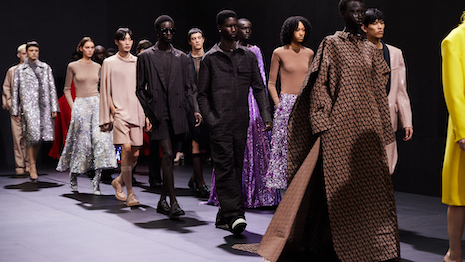
 The report lays out the state of inclusive business in the United Kingdom and beyond. Image credit: Valentino
The report lays out the state of inclusive business in the United Kingdom and beyond. Image credit: Valentino  The findings are informed by the DEI census taken last year. Image credit: BFC
The findings are informed by the DEI census taken last year. Image credit: BFC Representation in fashion, even externally, does not reflect customer demographics. Image credit: BFC
Representation in fashion, even externally, does not reflect customer demographics. Image credit: BFC Those at the top do not believe that there is a diversity problem. Image credit: BFC
Those at the top do not believe that there is a diversity problem. Image credit: BFC Companies that show that they prioritize DEI will secure a stronger workforce. Image credit: BFC
Companies that show that they prioritize DEI will secure a stronger workforce. Image credit: BFC